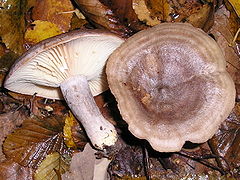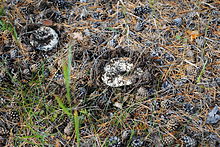- Lactarius
-
For the single-species genus of fish, see False trevally.
Lactarius 
Lactarius vietus Scientific classification Kingdom: Fungi Subkingdom: Dikarya Phylum: Basidiomycota Subphylum: Agaricomycotina Class: Agaricomycetes Order: Russulales Family: Russulaceae Genus: Lactarius
Pers. 1797Diversity c.400 species Lactarius is a genus of mushroom-producing fungi. The genus, collectively known commonly as milk-caps, are characterized by the fact that they exude a milky fluid ('latex') if cut or damaged. Like the genus Russula, with which they are grouped in the family Russulaceae, their flesh has a distinctive brittle consistency.
Often the gills are decurrent (starting to run down the stem) and the cap is depressed or even funnel-shaped when older. The stem and cap sometimes show 'strobicules' (or 'strobiculi'), which are flat-based shallow oval pits.
To identify to which of the roughly 400 Lactarius species a given specimen belongs, note whether the cap is bald/greasy or velvety or hairy/shaggy at the rim, particularly in young individuals. Also the initial colour of the milk (white, cream, orange, violet, ...) and the final colour on drying are determining characteristics.
The genus was described by Christian Hendrik Persoon in 1797. Lactarius is derived from the Latin lac 'milk'.
Contents
Ecology
Lactarius is one of the most prominent genera of ectomycorrhizal fungi.[1] With more than 400 species described worldwide, Lactarius taxa play a significant role as late-stage colonizers of trees and shrubs in a vast range of ecosystems, from boreal coniferous forests to temperate Mediterranean-type maquis. An interesting case is that of the strict association of selected Lactarius species - such as L. tesquorum and L. cistophilus - with Cistus spp., a group of about 20 woody, evergreen or semideciduous shrub species found in wide semi-arid areas from the Canary Islands throughout the Mediterranean region to the Caucasus. Cistus species are obligate seeding, early colonizers that follow disturbance, particularly fire, in low maquis-type Mediterranean ecosystems, rendering their ectomycorrhizal ecology particularly intriguing.[2][3]
A selection of well-known European species
- Lactarius turpis - ugly milk-cap
- Lactarius torminosus - woolly milk-cap
- Lactarius piperatus - peppery milk-cap
- Lactarius uvidus
Section Deliciosi
- Lactarius deliciosus
- Lactarius deterrimus
- Lactarius salmonicolor
This group of mushrooms has orange or red milk and carrot-orange coloration, in many cases becoming flecked with green or blue-green with age. They are all generally considered to be edible and tasty, the appetizingly named Lactarius deliciosus reputedly being much better than the others. They grow in coniferous woods.
L. deliciosus is the only one with an English name: 'saffron milk-cap'. It is found under pine or spruce. L. deterrimus was formerly considered to be a variety of L. deliciosus and is distinguished by the milk turning wine-red on drying - but only after up to 30 minutes. L. salmonicolor is associated with spruce and remains a pure orange, unlike the other two which discolour green.
Lactarius chrysorrheus
The milk of this mushroom emerges white but immediately changes to a deep yellow colour. The top of the cap is a pinkish red with concentric zoning on a background showing yellow tints. It is common under broad-leaved trees, especially oak. There are conflicting reports as to its edibility.
Lactarius decipiens
This flesh-coloured Lactarius is closely related to L. chrysorrheus, and again the milk is initially white and turns yellow, but only after several seconds. To allow the milk to contact the air this is best tested on a paper tissue (a cloth handkerchief is liable to be permanently stained).
Lactarius quietus
L. quietus, which is commonly found under oak trees, is often thought to be a non-descript mushroom, and in fact that is the significance of its Latin epithet quietus. It has a distinctive smell said to be of bedbugs or of wet laundry. The milk goes a little cream but does not change further.
See also
References
- ^ Rinaldi, A.C.; Comandini, O.; Kuyper, T.W. (2008). "Ectomycorrhizal fungal diversity: separating the wheat from the chaff". Fungal Diversity 33: 1–45. http://www.fungaldiversity.org/fdp/sfdp/33-1.pdf.
- ^ Nuytinck, J.; Verbeken, A.; Rinaldi, A.C.; Leonardi, M.; Pacioni, G.; Comandini, O. (2004). "Characterization of Lactarius tesquorum ectomycorrhizae on Cistus sp. and molecular phylogeny of related European Lactarius taxa". Mycologia 96 (2): 272–282. doi:10.2307/3762063. PMID 21148854. http://www.mycologia.org/cgi/content/full/96/2/272.
- ^ Comandini, O.; Rinaldi, A.C. (2008). "Lactarius cistophilus Bon & Trinbach + Cistus sp". Descriptions of Ectomycorrhizae 96: 83–88.
- Partly from Dutch Wikipedia pages.
- Meinhard Moser, translated by Simon Plant: Keys to Agarics and Boleti (Roger Phillips 1983)
- Régis Courtecuisse, Bernard Duhem : Guide des champignons de France et d'Europe (Delachaux & Niestlé, 1994–2000). ISBN 2-603-00953-2
- Roger Phillips : Mushrooms and other fungi of Great Britain and Europe (Pan Books Ltd. 1981 / Book Club Associates 1981) - for the English names.
- Annemieke Verbeken (2001). Worldwide systematics of Lactarius: a state of art. Micologia e vegetazione mediterranea, 16(1): 71-88
External links
- North American species of Lactarius by L. R. Hesler and Alexander H. Smith, 1979. (Full text of monograph.)
- Russulales News
Categories:
Wikimedia Foundation. 2010.





